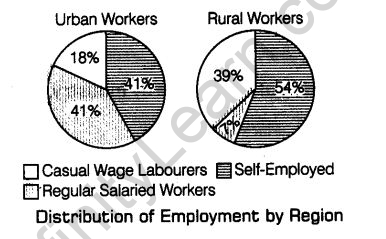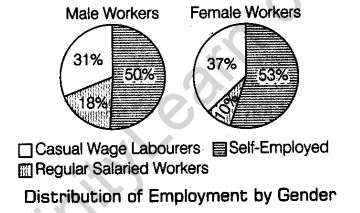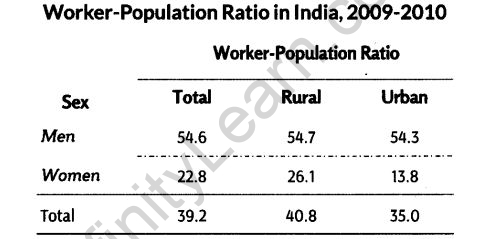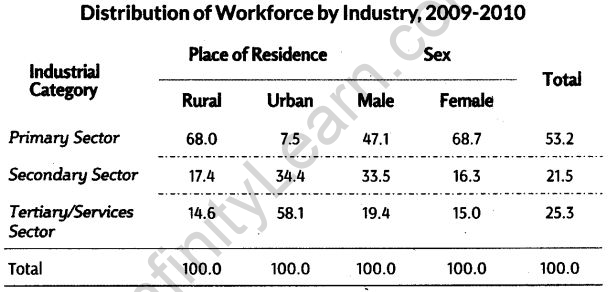Employment-Growth, Informalisation and Related Issues Class 11 Notes Chapter 7 Indian Economic Development
- Worker A worker is an individual who is in some employment to earn a living. He is engaged in some production activity.
- Production Activity It refers to the process of producing goods and services. Employed are those who are engaged in some production activity or the other.
- Self-employed and Hired Worker Self-employed workers are those who are engaged in their own business or own profession.
Hired workers are those who work for others they renders their services to other, as a reward, get wages/salaries or may be they are paid in kind. - Casual and Regular Worker Casual workers are the daily wagers. They are not hired by their employers on regular basis.
Regular workers are permanent pay-roll of their employers. A regular worker is usually a skilled worker. - Labour Supply It refers to supply of labour corresponding to different wage rates. Supply of labour is measured in terms of man-days of work and always studied with reference to wage rate.
- Labour Force It refers to the number of persons actually working or willing to work. It is not related to wage rate.
- Work Force It refers to the number of persons actually working and does not account for those who are willing to work.
- Employment in Firms, Factories and Offices In the course of economic development of a country, labour force from agriculture and other related activities to industry and services. In this process workers migrate from rural to urban areas.
- Informalisation of Workforce It refers to a situation where percentage of work force in the formal sector tends to decline and that in the informal sector tends to rise.
Market economy and informalisation of workers, perhaps are strongly correlated to each other.
Unemployment
According to Prof Pigou, “A man is unemployed only when he is both without a job a or not employed and also desires to be employed”.
- Rural Unemployment In Indian villages nearly 58.7% of labourers are engaged in primary sector. Most of the rural labourers engaged in non-farm sector work in cottage industries.
- Urban Unemployment In urban areas, unemployed people are often registered with employment exchanges. Therefore, urban unemployment is more like open unemployment.
Unemployment in urban sector is placed in two board categories- Industrial Unemployment
- Educated Unemployment
Common Types of Unemployment in Rural and urban Areas
In India, following types of unemployment are found both in urban and rural areas
- Open unemployment
- Structural unemployment
- Under employment
- Frictional unemployment
- Cyclical unemployment
Suggestions to Solve the Problem of Unemployment in India
- Increase in production
- Increase in productivity
- High rate capital formation
- Help to self employed persons
- Technique of production
- Co-operative industries
Government Policy and Programmes
Government seeks to solve the problem of unemployment through its poverty eradication programmes generating employment opportunities for poorer sections of the society. Rural employment Guarantee scheme is a significant recent attempt of the government, offering guaranteed employment to those in the rural areas who are below poverty line.
Some of the basic issues related to unemployment in India are emphasised in this chapter. It also addresses the growth rate of Indian economy and various employment generation, schemes. It also specifies the need of transformation of workers from in formal sector to formal sector.
Employment and Informalisation of Indian workforce
Work plays an important role in our lives as an individual or a group of members can earn their living after doing work. Being employed gives us a sense of self-worth and enables us to relate ourselves meaningfully with others. In this way, every working person can actively contribute towards national income.
Thus, there is need to know who is a worker and what is an employment.
A person is classed as a worker if
- he has contract or agreement to do work.
- he gets reward or other benefits from doing a work.
- he works for himself or is self-employed.
So, it can be concluded that all those who are engaged in production activities, in whatever capacity high or low, are workers.”
Types of Workers
Broadly, workers can be categorised into self-employed and hired workers. They are discussed below
- Self-Employed The workers who own and operate an enterprise to earn their livelihood are known as self-employed.
For example, a farmer working on his own farm. This category accounts for more than 50% of the workforce. - Hired Workers Those people who are hired by others and are paid wages or salaries as a reward for their services are called hired workers.
Hired workers can be of two types
- Casual Workers Those people, who are not hired by their employers on a regular/permanent basis and do not get social security benefits are said to be casual workers.
For example, construction workers. - Regular Salaried Workers When a worker is engaged by someone or by an enterprise and paid his or her wages on a regular basis, they are known as regular salaried employees or regular workers.
For example, teachers, chartered accountants, etc.
Self-Employed and Hired Workers in India
1. According to Region (Rural and Urban)
- 41% of workers are self-employed and 59% of workers are hired in urban areas.
- 54% of workers are self-employed and 46% of workers are hired in rural areas.

The above chart shows that the self-employed and casual wage labourers are found more in rural areas than in urban areas. It is -because in urban areas, people are skilled and work for jobs in offices and factories. But in rural areas, people work on their own farms.
2. According to Gender
- 50% of male workers are self-employed and 50% of male workers are hired.
- 53% of female workers are self-employed and 47% of female workers are hired.

Distribution of Employment by Gender The above chart shows that self-employment and hired employment are equally important for male workers. But female workers give preference to self-employment than to hired employment. It is because women, both in rural and urban areas are less mobile and thus, prefer to engage themselves in self employment.
So, it can be concluded that self-employment is a very important source of livelihood for people in India. Size of Workforce in India. India has a workforce of nearly 40 crore of people.
The data on the size of workforce In India are as follows
- About 70% of the workforce comprises of male workers, only 30% are female workers,
- Nearly, 70% of workforce is found in rural areas i and only 30% is in urban areas.
- Percentage of female workforce In rural areas is nearly 26% while it is only 14% in urban areas.
Employment
It is a relationship between two parties i.e. employer and the employee who are binded in a contract of doing something valuable or it is an act of employing or state of being employed.
The nature of employment in India is multifaceted. Some get employment throughout the year or some others get employed for only a few months in a year. Many workers do not get fair wages for their work but still while estimating the numbers of workers, all those who are engaged in productive activities are included as employed.
Terms associated with workers and employment are accumulated below
- Productive Activities Those activities which contribute to the gross national product are called productive activities.
- Workforce Persons who are engaged in productive activities are termed as workers and they constitute the workforce.
Workforce is the total number of persons actually working. - Workforce Participation Rate (Ratio) It is measured as the ratio between workforce and total population of a country.

- Labour Supply It refers to the amount of labour that the workers are willing to work, corresponding to a particular wage rate.
- Labour Force It refers to he number of workers actually working or who are able to work. It is not related to wage rate.
- Rate of Unemployment

Participation of People in Employment
It refers to participation of people induction activity. It is measured as a ratio of or force to total population of the country.
The data on rate of participation of people in employment are as follows
- Rate of participation for the urban areas is about 35%.
- Rate of participation for the rural areas is about 41%.
- In urban areas, rate of participation is about 54.3% for men and 13.8% for women.
- In rural areas, rate of participation is about 54.7% for men and 26.1 % for women.
- Overall rate of participation in the country is about 39.2%.
Worker-Population Ratio in India, 2009-2010 Worker-Population Ratio

The above data reveals the following
- Overall rate of participation in the country is not very high, implying not many people are engaged in production activity.
- Participation rate in rural areas is higher than in urban areas.
- Participation rate for women is higher in rural areas compared with urban areas.
Employment in Firms, Factories and Offices
In the course of economic development of a country, labour flows from agriculture and other related activities to industry and services. In this process, workers migrate from rural to urban areas.
Generally, we divide all productive activities into different industrial divisions, they are as follows
- Primary Sector It includes agriculture, forestry and logging, Ashing, mining and quarrying.
- Secondary Sector It includes manufacturing, construction, electricity, gas and water supply.
- Tertiary Sector It includes trade, transport, storage and services.

Growth and Changing Structure of Employment
During the period 1960-2000, Gross Domestic Product (GDP) of India grew positively and was higher than the employment growth. However, there was always fluctuation in the growth of GDP. During this period, employment grew at a stable rate of about 2%.

In 1972-73, about 74% of workforce was engaged in primary sector and in 2009-10, this proportion has declined to 53%. Secondary and service sectors are showing promising future for the Indian workforce.The distribution of workforce in different status indicates that over the last four decades (1972-2010), people have moved from self employment and regular salaried employment to casual wage work. Yet self-employment continues to be the major employment provider.
The movement of labour from regular workers to casual wage workers is known as The Process of casualization.

The chart given above points that in the late 1990s, employment growth started declining and reached the level of growth that India had in the early stages of planning. During these years, there is a widening gap between the growth of GDP and employment. This means that in the Indian economy, without generating employment, we have been able to produce more goods and services. This phenomenon is referred as Jobless Growth.
Distribution of workforce by industrial sectors shows substantial shift from farm work to non-farm work.
Informalisation of Indian Workforce
Development planning in India is always focused to provide decent livelihood to its people. It was thought that the industrialisation strategy would bring surplus workers from agriculture to industry with better standard of living as in developed countries. Over the years, the quality of employment has been deteriorating. A small section of Indian workforce is getting regular income. The government through its labour laws, enable them to protect rights in various ways. This section of workforce forms trade unions, bargains with employers for better wages and other social security measures.
Workforce can be classified into two categories
Formal Sectors All the public sector establishments and those private sector establishments which employ 10 hired workers or more are called formal sector establishments and those who work in such establishments are formal sector workers.
Informal Sectors All other enterprises and workers working in those enterprises form the informal sector. Informal sector includes millions of farmers, agricultural labourers, owners of small enterprises and people working in those enterprises as also the self employed who do not have any hired workers.
Those who are working in the formal sector enjoy social security benefits. They earn more than those in the informal sector. Workers and enterprises in the informal sector do not get regular income; they do not have any protection or regulation from the government. Workers are dismissed without any compensation.
As the economy will grow, more and more workers would become formal sector workers. Owing to the efforts of the International Labour Organisation (ILO), the Indian government has initiated the modernisation of informal sector.
Informalisation in Ahmedabad Ahmedabad is a prosperous city with its wealth based on the produce of more than 60 textile mills with a labour force of 150000 workers employed in them. These workers had, over the course of the century, acquired a certain degree of income security.
They had secure jobs with a living wage, they were covered by social security schemes protecting their health and old age. They had a strong trade union which not only represented them in disputes but also ran activities for the welfare of workers and their families. In the early 1980s, textile mills all over the country began to close down. In some places, such as Mumbai, the mills closed rapidly.
In Ahmedabad, the process of closure was long drawn out and spread over 10 years. Over this period, approximately over 80000 permanent workers and over 50000 non-permanent workers lost their jobs and were driven to the informal sector.
The city experienced an economic recession and public disturbances, especially communal riots. A whole class of workers was thrown back from the middle class into the infor mal sector, into poverty. There was widespread alcoholism.
Unemployment
In every section of society there will be a large number of unemployed persons. It is a situation, in which all those who, owing to lack of work are not working but either seek work through employment exchanges, intermediaries, friends or relatives or by making applications to prospective employers or express their willingness or availability for work under the prevailing condition of work and remunerations.
There are a variety of ways by which an unemployed person is identified. As per the view 4)f some economists, unemployed person is one who is not able to get employment of even one hour in half a day.
One can get the data of unemployed persons through below stated sources
- Reports of Census of India
- NSSO’s (National Sample Survey Organisations) reports of employment and unemployment situation
- Directorate General of Employment and Training Data of Registration with Employment Exchanges.
Types of Unemployment in India

1. Rural Unemployment
Around 70% of India’s population lives in village. Agriculture is the single largest source of their livelihood. Agriculture suffers from a number of problems like dependence upon rainfall, financial constraints, obsolete techniques, etc.
Rural unemployment can be of following three types
- Open Unemployment It refers to that situation wherein the worker is willing to work and has the necessary ability to work yet he does not get work and remains unemployed for full time. ”
- Seasonal Unemployment It refers to a situation where a number of a persons are not able to find a job in a particular season. It occurs in case of agriculture, ice-cream factories, woollens factories, etc.
- Disguised Unemployment It exists when marginal physical productivity of labour is zero or sometimes it becomes negative. Important features of disguised unemployment are as under
- Marginal physical productivity of labour is zero.
- There is disguised unemployment among wage earners.
- Disguised unemployment is invisible.
- It is different from industrial unemployment.
2. Urban Unemployment
In urban areas, unemployed people are often registered with employment exchanges. Between 1961 and 2008, the number of unemployed registered in employment exchanges has increased more than eight-fold.
Urban unemployment is of three types
- Industrial Unemployment It includes those illiterate persons who are willing to work in industries, mining, transport, trade and construction activities, etc.
Problem of unemployment in industrial sector has become acute because of increasing migration of rural people to urban industrial areas in search of employment. - Educated Unemployment In India the problem of unemployment among the educated people is also quite grave. It is a problem spread across all parts of the country, because the massive expansion of the education facilities have contributed to the growth of educated persons who are on the look out for white collar jobs.
- Technological Unemployment Technological upgradation is taking place in all spheres of activity.
People who have not updated their skills in the latest technology become technologically unemployed.
Causes of Unemployment in India
1. Slow Economic Growth In Indian economy, the rate of economic growth is very slow. This slow growth rate fails to provide enough employment opportunities to the rising population. Supply of labour is much more than the available employment opportunities.
2. Rapid Growth of Population Constant increase in population has been a grave problem of India. It is one of the main causes of unemployment. The number of unemployed has actually increased instead of decreasing during the plan period.
3. Faulty Employment Planning The Five Year Plans in India have not been designed for employment generation. A frontal attack to solve the problem of unemployment is missing. It was thought that economic growth will take care of unemployment problem.
4. Excessive Use of Foreign Technology Lack of scientific and technical cosearch at home, due to its high cost has resulted in excessive use of foreign technology which has led to technical unemployment in our country.
5 Lack of Financial Resources The expansion and diversification programme of agriculture and small scale industries have suffered because of lack of financial resources. This has been accompained by increasing government control of economic activities.
6. Increase in Labour Force The population explosion stage of Indian economy has added young people to the labour force who are seeking employment.
Government and Employment Generation
In 2005, the government had passed an act in parliament known as the National Rural Employment Guarantee Act, 2005. It promises 100 days of guaranteed wage employment to all rural households who volunteer to do unskilled manual work. This scheme is one of the important measure adopted by government to generate employment for those who are in need of jobs in rural areas.
Since independence, the Union and State Government have played an important role in generating employment or creating opportunities for employment generation. Their efforts can be broadly categorised into two i.e., direct and indirect.
- Direct Employment, In this government employs people in various departments for administrative purposes. It also runs industries, hotels and transport companies and hence provides employment directly to workers.
- Indirect Employment It can be understood as when output of goods and services from government enterprises increases, then private enterprises which receive now materials from government enterprises will also raise their output and hence increase the number of employment opportunities in the economy. This is the indirect generation of employment opportunities by the government initiatives in the economy.
Employment Generation Programmes
Many programmes that governments implement with the aim of alleviating poverty through employment generation are called employment generation programmes.
These programmes aim at providing not only employment but also services in areas such as primary health, primary education, rural drinking water, nutrition, assistance for people to buy income and employment generating assets, development of community assets by generating wage employment, construction of houses and sanitation, assistance for constructing houses, laying of rural roads, development of waste lands/degraded lands.



